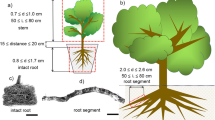Abstract
The role of phloem anastomoses in translocation was studied experimentally in intact and wounded internodes ofDahlia pinnata Cav. Translocation was visualized with fluorescein, a fluorescent dye capable of movement in the phloem. Translocation was analyzed in large areas of living phloem tissue which were peeled from the xylem at the cambium region. Under normal conditions, fluorescein was observed in sieve tubes of the longitudinal phloem strands but very rarely in the sieve tubes of the anastomoses. However, when a few longitudinal strands were severed, fluorescein was translocated through the anastomoses located around the wound within 24 h. It is suggested that the phloem anastomoses in mature internodes ofDahlia serve mainly as an emergency system which enable a fast response to damage by providing alternative pathways for assimilates around the stem. A possible regulatory mechanism based on differences in resistance to flow in longitudinal versus lateral sieve tubes is discussed.
Similar content being viewed by others
References
Aloni, R. (1974) Organized differentiation of vascular tissues. [In Hebrew] Ph.D. thesis, Hebrew University, Jerusalem, Israel
Aloni, R. (1987a) The induction of vascular tissues by auxin. In: Plant hormones and their role in plant growth and development, pp. 363–374, Davies, P.J., ed. Nijhoff/Junk, The Hague
Aloni, R. (1987b) Differentiation of vascular tissues. Annu. Rev. Plant Physiol.38, 179–204
Aloni, R., Jacobs, W.P. (1977) The time course of sieve tube and vessel regeneration and their relation to phloem anastomoses in mature internodes ofColeus. Am. J. Bot.64, 615–621
Aloni, R., Sachs, T. (1973) The three-dimensional structure of primary phloem systems. Planta113, 345–353
Aloni, R., Raviv, A., Wolf, A. (1986) Effect of light intensity on the differentiation of phloem anastomoses in cucumber seedlings. (Abstr.) Am. J. Bot.73, 618
Aloni, R., Baum, S.F., Peterson, C.A. (1990) The role of cytokinin in sieve tube regeneration and callose production in woundedColeus internodes. Plant Physiol.93, in press
Biddulph, O. (1941) Diurnal migration of injected radiophosphorus in bean seedlings. Am. J. Bot.28, 348–352
Biddulph, O., Cory, R. (1965) Translocation of C14 metabolites in the phloem of the bean plant. Plant Physiol.40, 119–129
Crafts, A.S., Crisp, C.E. (1971) Phloem transport in plants. Freeman and Co., San Francisco
Crisp, C.E., Look, M. (1978) Phloem loading and transport of weak acids. In: IUPAC Advances in Pesticide Science, Plenary Lectures, pt. 3, pp. 403–437, Giessbuhler, H.G., Brooks, G.T., Kearney, D.C., eds. Pergamon Press, Oxford, UK
Eschrich, W. (1953) Beiträge zur Kenntnis der Wundsiebröhren-Entwicklung beiImpatiens holsti. Planta43, 37–74
Eschrich, W., Currier, H.B., Yamaguchi, S., McNairn, R.B. (1965) Der Einfluss verstärkter Callosebildung auf den Stofftransport in Siebröhren. Planta65, 49–64
Grusak, M.A., Lucas, W.J. (1984) Recovery of cold-inhibited phloem translocation in sugar beet I. Experimental analysis of an existing mathematical recovery model. J. Exp. Bot.35, 389–402
Grusak, M.A., Lucas, W.J. (1986) Cold-inhibited phloem translocation in sugar beet III. The involvement of the phloem pathway in source-sink partitioning. J. Exp. Bot.37, 277–288
Jacobs, W.P. (1970) Regeneration and differentiation of sieve-tube elements. Int. Rev. Cytol.28, 239–273
Jacobs, W.P. (1984) Functions of hormones at tissue level of organization. In: Encyclopedia of Plant Physiology, N.S., vol. 10: Hormonal regulation of development. II. The functions of hormones from the level of the cell to the whole plant, pp. 149–171, Scott, T.K., ed. Springer, Berlin Heidelberg New York
Oross, J.W., Lucas, W.J. (1985) Sugar beet petiole structure: vascular anastomoses and phloem ultrastructure. Can. J. Bot.63, 2295–2304
Oross, J.W., Grusak, M.A., Lucas, W.J. (1986) Regulation of long-distance translocation in sugar beet: structural aspects. In: Phleom transport, pp. 477–486, Cronshaw, J., Lucas, W.J., Giaquinta, R.T., eds. Liss, New York
Peterson, C.A., Currier, H.B. (1969) An investigation of bidirectional translocation in the phloem. Physiol. Plant.22, 1238–1250
Prazak, J.A., Peterson, C.A. (1987) A rapid fluorescence method for observing phloem regeneration inColeus blumei. Stain Technol.62, 276–278
Roberts, L.W., Gahan, P.B., Aloni, R. (1988) Vascular differentiation and plant growth regulators. In: Springer Series in Wood Science, Timell, T.E., ed. Springer, Berlin Heidelberg New York
Rouschal, E. (1941) Untersuchungen über die Protoplasmatik und Funktion der Siebröhren. Flora135, 135–200
Schulz, A. (1986a) Wound phloem in transition to bundle phloem in primary roots ofPisum sativum L. I. Development of bundle-leaving wound-sieve tubes. Protoplasma130, 12–26
Schulz, A. (1986b) Wound phloem in transition to bundle phloem in primary roots ofPisum sativum L. II. The plasmatic contact between wound-sieve tubes and regular phloem. Protoplasma 130, 27–40
Schulz, A. (1986c) The beginning of translocation in wound phloem. In: Phloem transport, pp. 183–185, Cronshaw, J., Lucas, W.J., Giaquinta, R.T., eds. Liss, New York
Schulz, A. (1987) Sieve-element differentiation and fluorescein translocation in wounded phloem of pea roots after complete severance of the stele. Planta170, 289–299
Schumacher, W. (1933) Untersuchungen über die Wanderungen des Fluoreszeins in den Siebröhren. Jahrb. Wiss. Bot.77, 685–732
Stadelmann, E.J., Kinzel, H. (1972) Vital staining of plant cells. In: Methods in cell physiology V, pp. 325–372, Prescott, D.M., ed. Academic Press, New York London
von Kaan-Albest, A. (1934) Anatomische und physiologische Untersuchungen über die Entstehung von Siebröhrenverbindungen. Z. Bot.27, 1–94
Author information
Authors and Affiliations
Additional information
This study was supported by an International Scientific Exchange award and an operating grant to C.A.P. from the Natural Sciences and Engineering Research Council of Canada.
Rights and permissions
About this article
Cite this article
Aloni, R., Peterson, C.A. The functional significance of phloem anastomoses in stems ofDahlia pinnata Cav.. Planta 182, 583–590 (1990). https://doi.org/10.1007/BF02341035
Accepted:
Issue Date:
DOI: https://doi.org/10.1007/BF02341035




